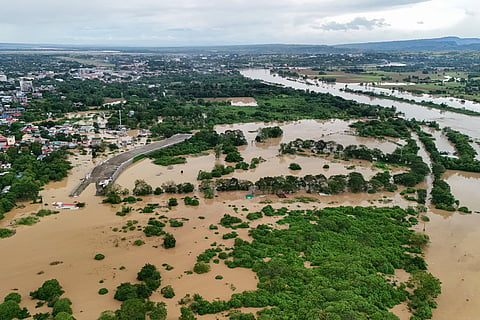Day after Uwan (Fung-wong): Supertyphoon leaves a trail of death, destruction in the Philippines
155 cities, towns without power as 21st typhoon hits Asian nation in 2025

Manila: Typhoon Uwan (internationally named Fung-Wong) unleashed nature’s fury across the Philippines, leaving vast swaths of communities underwater from Bicol to Northern Luzon.
The monster storm roared ashore with sustained winds reaching a terrifying 185 km/h, initially making landfall as a super typhoon before weakening while rumbling over Luzon’s heartland.
Uwan’s impact saw over a million residents evacuated amid Signal No. 5 storm alerts in southeastern Luzon, with images of families clutching their belongings as they scrambled to escape dangerous flooding.
On Catanduanes Island, especially San Miguel, harrowing flash floods inundated neighborhoods, forcing families to rush to higher ground as heavy rains masked the landscape in fog.
Farther north, Isabela and the Cagayan Valley felt the storm’s wrath as rivers burst their banks and residents braced for relentless winds and surging waters.
The situation in Pangasinan, including historic Dagupan City, was no different—Uwan’s wrath transformed streets into rivers and paralyzed daily life. Schools canceled classes, flights were grounded, and local governments declared a state of calamity to mobilize rescue and relief.
At least 31 national road sections across eight regions were closed due to flooding, landslides, and other hazards caused by Uwan.
18 hours of strong winds
Up to 18 hours of strong winds and continuous severely impacted economic activity in several towns and cities on the Luzon mainland, highlighting the typhoon's extensive reach and the challenges faced by residents.
The Philippines experienced its 21st significant storm of the year, facing challenges from consecutive typhoons, with Uwan categorised as a super typhoon due to its sustained winds of 185 km/h and gusts up to 230 km/h.
One video captures the dire situation in Catanduanes, where storm surges and flooding have submerged homes, reflecting the urgent need for disaster preparedness and response in vulnerable areas.
This typhoon follows closely on the heels of Typhoon Tino (Kalmaegi), which had already caused significant damage, killing nearly 200 people in the central Philippines and five in Vietnam, highlighting a pattern of intense weather events in the region.
The flooding in many parts of the country form part of a broader impact, with over 1 million people evacuated nationwide and at least two deaths reported due to Uwan, straining the country's disaster response capabilities.
In Quezon City, a component city of the National Capital Region, outdated drainage systems led to head-deep floods, indicating a recurring issue with urban flooding during heavy rains.
Social media buzzed with scenes of rescue operations, airlifts, and urgent warnings from disaster officials, all underscoring the storm’s wrath.
With Metro Manila under a high alert for flood control and emergency response, the aftermath saw communities rallying amid hardship, determined to overcome a disaster that hammered the country less than a week after the devastation caused by Typhoon Tino (Kalmaegi).
Super Typhoon Uwan’s rapid weakening over the West Philippine Sea signals some relief, but the scars of torrential rain, swelling rivers, and battered infrastructure will shape recovery efforts for weeks to come.
Sign up for the Daily Briefing
Get the latest news and updates straight to your inbox



